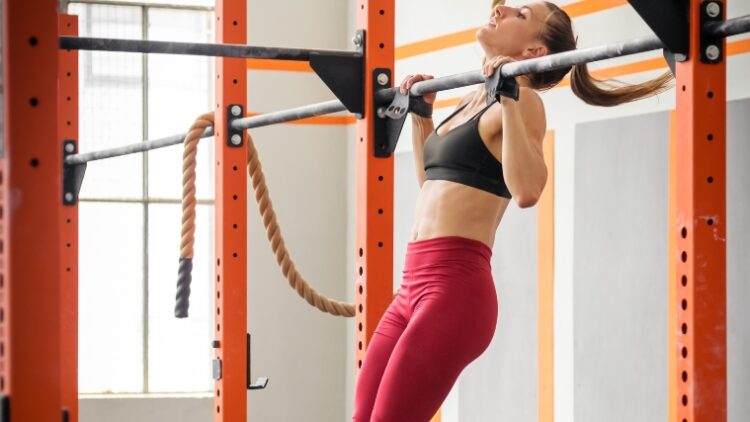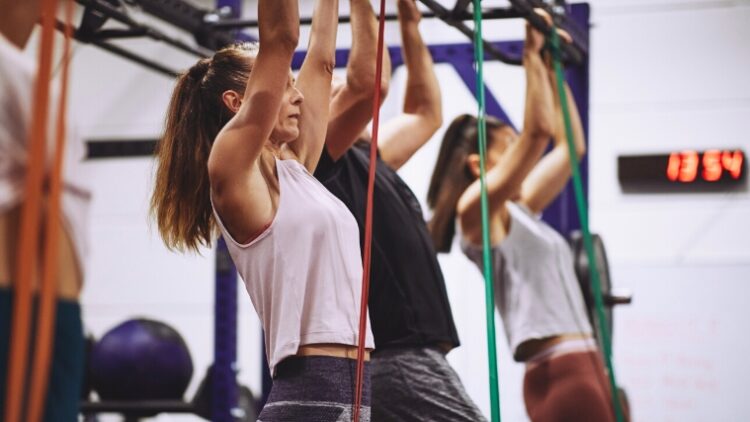In most strength sports, you measure your progress with one-rep maxes and carefully calculated sets and reps. In CrossFit, you assess yourself by repeatedly pushing as hard as you can, as fast as you can. To give yourself an objective measure of how far you’ve come, you’ll perform benchmark workouts to compare the present you to the past you.
The CrossFit Fran workout is a classic WOD (workout of the day) that athletes have used to mark their progress since it debuted on the CrossFit scene in 2003. Fran is deceptively simple, consisting of two exercises, and it’s generally performed in under 10 minutes.
But what Fran lacks in complexity, it makes up for with its intense demand on your full body strength, endurance, and your ability to stay calm (but fast) under pressure. Here, you’ll find out everything you need to know about Fran. No matter what your experience level, you’ll soon learn how to scale Fran to perform at your best — and continue improving.
- What is the Fran Workout?
- What Are Good Fran Times?
- Strategies for the Fran Workout
- How to Scale Fran for Beginners
- How to Scale Fran for Intermediates
- How to Scale Fran for Advanced Athletes
What is Fran?
Fran is a CrossFit benchmark workout that consists only of two exercises — thrusters and pull-ups. You’ll perform 90 reps total: 45 thrusters and 45 pull-ups. The rep scheme descends from 21 to 15 to nine.
This means that the biggest block of work happens right off the bat. This workout is a chipper. You’ll complete each set before moving on to the next. Go in order — thrusters, then pull-ups, then thrusters again, etc. — chipping away at the workout until it’s complete.
The Workout
For time:
Women: 65-pound barbell
Men: 95-pound barbell
The goal of Fran is to go fast and as close to unbroken as you can. Athletes of any gender can select a weight that matches their strength, endurance, and experience level.
What Are Good Fran Times?
In the fall of 2022, CrossFit great Noah Ohlsen completed Fran in just one minute and forty-nine seconds — an unofficial world record captured on video, according to the Morning Chalk Up. Two years earlier, CrossFitter Marisa Flowers completed the workout in a brisk one minute and fifty-three seconds.
But assuming you’re not quite on the level of Ohlsen and Flowers, where can you expect your Fran time to fall? Standards continually shift in CrossFit as the sport evolves, but here are some general guidelines that you might try to see yourself in.
- Elite: less than two minutes
- Advanced: between two and four minutes
- Intermediate: between four and eight minutes
- Beginner: between eight and 10 minutes
If your time is hitting the double digits, consider reexamining your strategy or scaling the workout. The goal here is speed — so as long as your form is dialed in, you can modify as needed.
Strategies for Fran Workout
Just because the workout is fast doesn’t mean you go in without a strategy. Indeed, sometimes the faster workouts require the most forethought. From knowing the rules of the WOD to figuring out your planned rep scheme, you’ll need to go in with a plan.
Perform it as a Chipper
There are plenty of things you can modify during Fran. You can scale everything from the weight you’re using to what specific movements you’re performing.
But the one thing everyone will have in common with Fran is this workout is a chipper. That means that you must perform all 21 thruster reps, then all 21 pull-up reps. Only once you’ve performed your sets of 21 will you move onto your sets of 15 — thrusters first, then pull-ups. It’s the same story with your sets of nine.
Make sure you’re following that formula of completing each set before moving on to the next. That way, no matter your modifications, you’ll be performing Fran as intended.
Aim to Go Unbroken
The goal with this chipper is to perform each set unbroken. This means that you’ll try to perform each set without resting in between reps.
If you can’t do 21 thrusters and/or pull-ups unbroken, plan ahead to take quick, strategic breaks. That might mean breaking the sets of 21 into three smaller sets of seven reps each. With the sets of 15, perhaps a set of eight and a set of seven will help you be more efficient.
The goal, however, is to go unbroken. That might mean reducing the weight or modifying the movement to ensure that you can get as close as possible to finishing Fran unbroken. If you’re finding that you need to split your movements into very small sets of three or four reps each, you might want to reduce the weight.
Drive With Your Legs
You absolutely want to avoid form breakdown in any WOD. In such a lightning-fast workout, you need to maximize your “rest” where you can. In Fran, that means using your legs as much as possible to fuel your thrusters.
[Read More: The Best Leg Exercises for Your Next Leg Day]
The nature of any well-done thruster is channeling momentum from your front squat into the overhead portion of your lift. However, pushing off explosively with your legs to transfer as much force as possible into hoisting the barbell overhead is especially important during Fran. That’s because your upper body is going to be toast from all those pull-ups.
Give yourself as much of a “break” as you can by taking pressure off your upper body during the thrusters as much as possible. Practice developing as much speed and power in your legs as possible to really set yourself up for success here.
Practice Kipping Pull-Ups
If you’ve never performed a kipping pull-up, Fran is a good workout in which to learn. If you really want to tackle this WOD and post a good score, kipping pull-ups are fairly essential. The kipping pull-up differs significantly from a regular strict pull-up. With your kip, you’ll use momentum to arch your body back and forth. This will generate the push you need to get your chin over the bar.
Kipping pull-ups may look like they don’t require a lot of discipline because they use so much momentum. But to properly perform a kipping pull-up, you need excellent control of your core, fantastic shoulder mobility and stability, and a tremendous amount of lat strength.
Practice kipping pull-ups outside the intense time constraints of Fran so that when time is limited, the proper form will come naturally to you.
How to Scale Fran for Beginners
Any CrossFit WOD can be intimidating for beginners. Even seasoned veterans of the sport can be cowed by the classic toughness of benchmark WODs. So as a beginner, don’t be ashamed of needing to scale Fran. Even the greats need to do it sometimes.
Modify the Thrusters
Thrusters look somewhat simple — a front squat plus a push press, then repeat. But this benchmark workout calls for high volume and barbell work. That can be a very difficult combination for any athlete, but especially a beginner.
[Read More: The Best Upper Body Exercises and Workouts]
Doing thrusters with a barbell demands a lot of refined technique, making sure that your wrists are in the proper position to transition from the front rack into the press. Your front-rack position also needs to be impeccable. A beginner may simply not have that refined technique yet.
To work around this, you can opt to work with an empty barbell. But this might be too heavy at high volume. Plus, without the requisite wrist flexibility and strength, transitioning from a front-rack position to an overhead press with a barbell may be out of reach.
Instead, opt to use a pair of dumbbells or resistance bands for your thrusters. This will allow your wrists a lot more leeway. From here, you can get used to the sheer volume, strength, and endurance you need to succeed at Fran.
Modify the Pull-Ups
To make Fran as fast as possible, you’ll want to opt for kipping pull-ups. But as a beginner, you may not be able to perform a strict pull-up yet — let alone the kipping variety.
If you’re more concerned about training pull-ups than you are timing, you might opt to perform strict pull-ups with a resistance band. This will significantly slow your time down. But as a beginner, you might decide that’s a worthwhile exchange just to get exposed to this type of volume.
To continue aiming for speed, you might instead try jumping pull-ups. You’ll jump up from the ground or a plyo box with each rep to help give yourself momentum to poke your chin over the bar. These will typically go a lot faster than strict pull-ups or assisted pull-ups, but you’ll still get the training stimulus of a pull-up.
If jumping pull-ups still feel out of reach, you can opt to perform inverted rows or ring rows instead of pull-ups entirely. You can also start with jumping pull-ups and switch to inverted rows if that can help you keep your movements relatively unbroken.
How to Scale Fran for Intermediates
As an intermediate athlete, you can still continue to modify the thrusters, pull-ups, or both. Having an intermediate strength level or experience with CrossFit doesn’t automatically make you good at thrusters and kipping pull-ups. So feel free to continue modifying the movements as needed.
Lower the Weight
If you have your thrusters and pull-up form down, you may still find Fran overwhelming. Just because you can perform these movements with good form doesn’t mean you can do them at 95 or 65 pounds at high volume.
Remember that the idea with Fran is building up speed. To that end, there’s no shame in using less weight with the aim of going faster (while maintaining good form). Select a weight with which you can perform as many unbroken reps as possible.
Even if the weight you end up with seems very light, use what you need to keep your sets unbroken. Make that your goal and have it reflected in your weight selection. Just make sure you jot down which weight you’re using so you can accurately get an idea of Fran as a benchmark.
How to Scale Fran for Advanced Athletes
Even advanced athletes may need to scale Fran down. This might be because you’re coming back from an injury, looking to take a more active recovery approach to the workout, or if you’re having a rough training day. Fran might also happen to include your least favorite movements.
But you may be searching for a way to make Fran even more of a challenge. Here are some ways to do just that.
Improve Your Technique
The first thing to know is that this workout aims for speed. To get better at Fran, you need to get more efficient with your movements. While this is true for beginners and intermediates, too, it’s especially important for advanced athletes to shave as many seconds off their time as they can. The way forward there is maximizing technique.
To do a faster Fran, dial in your thruster technique. When you’re not performing Fran, consider incorporating speed training into your front squat work. Perform plenty of thrusters to maximize your efficiency in getting the bar from the front rack position to overhead.
For the pull-up portion, perform high-rep kipping pull-ups to help yourself perform unbroken reps as quickly as possible,
Add Some Weight
Performed this benchmark workout at a speed that feels like your max multiple times. Perhaps you hit within a few seconds of the three-minute mark consistently over time. If you’re satisfied with your speed but still want a challenge, consider a different intensity booster.
You can add a small amount of weight to the bar to progressively overload this benchmark workout. Record your time and perform it again with the same increased weight later in your program.
Fran at All Levels
CrossFit benchmark workouts are meant to be tough. But they’re also meant to measure your progress, and there are few better ways to measure your speed and endurance than Fran. The CrossFit Fran workout will force you to maximize your technique and perform at your absolute best. You’ll have no choice because this workout is fast and absolutely furious.
If you can’t complete Fran as prescribed yet, no problem. You can still give yourself the desired training stimulus with some simple modifications that will make a big difference. Whether you’re using dumbbells or a barbell, jumping pull-ups or inverted rows, try Fran out and see how fast you can go.
Featured Image: Dragon Images / Shutterstock






